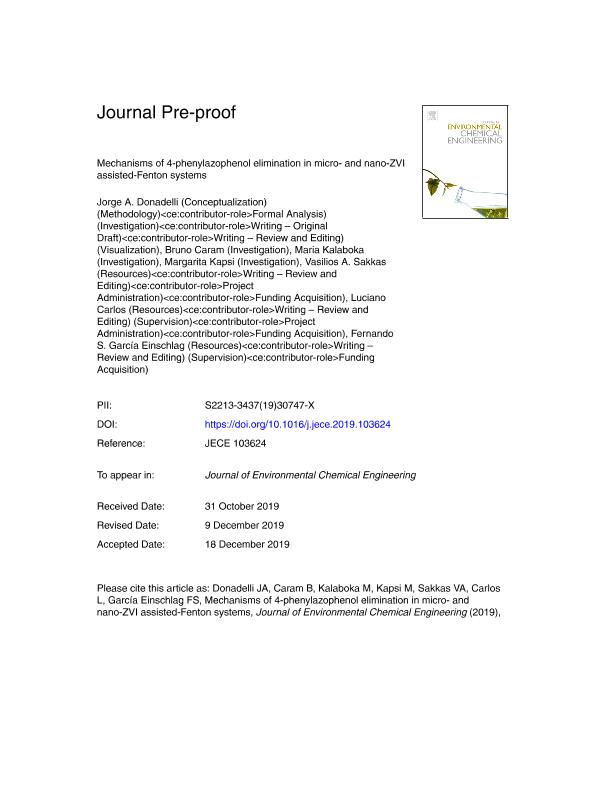Artículo
Mechanisms of 4-phenylazophenol elimination in micro- And nano-ZVI assisted-Fenton systems
Donadelli, Jorge Andrés ; Caram, Bruno Federico
; Caram, Bruno Federico ; Kalaboka, Maria; Kapsi, Margarita; Sakkas, Vasilios A.; Carlos, Luciano
; Kalaboka, Maria; Kapsi, Margarita; Sakkas, Vasilios A.; Carlos, Luciano ; Garcia Einschlag, Fernando Sebastian
; Garcia Einschlag, Fernando Sebastian
 ; Caram, Bruno Federico
; Caram, Bruno Federico ; Kalaboka, Maria; Kapsi, Margarita; Sakkas, Vasilios A.; Carlos, Luciano
; Kalaboka, Maria; Kapsi, Margarita; Sakkas, Vasilios A.; Carlos, Luciano ; Garcia Einschlag, Fernando Sebastian
; Garcia Einschlag, Fernando Sebastian
Fecha de publicación:
02/2020
Editorial:
Elsevier
Revista:
Journal of Environmental Chemical Engineering
ISSN:
2213-3437
Idioma:
Inglés
Tipo de recurso:
Artículo publicado
Clasificación temática:
Resumen
The 4-phenylazophenol (4-PAP), was treated with two different sources of metallic iron (ZVI): commercial micrometric powder (pZVI) and nanoparticles synthetized by the borohydride reduction method (nZVI). 4-PAP degradation was studied both in the absence and in the presence of H2O2 at different pHs. The degradation products of 4-PAP in each treatment were followed by LC-MS and CG-MS. Results showed that, in the absence of H2O2, the azo bond reduction of 4-PAP with the formation of amines was the main mechanism involved for both ZVI sources and nZVI exhibited a faster substrate removal than pZVI. In the presence of H2O2, an additional mechanism involving the oxidation mediated by hydroxyl radicals takes place. For pZVI, the addition of H2O2 produced a complete inhibition of the reduction pathway, being the oxidation the main degradation mechanism. In the case of nZVI, the system behavior showed an important dependence on the working pH. At pH 3.00, oxidative transformation pathways prevailed, whereas at pH 5.00 an almost negligible degradation -mainly driven by 4-PAP reduction- was observed. The assessment of the involved reaction mechanisms under different conditions allows the selection of the most suitable source for a specific treatment.
Palabras clave:
AZO DYES
,
FENTON
,
IRON NANOPARTICLES
,
ZVI
Archivos asociados
Licencia
Identificadores
Colecciones
Articulos(INIFTA)
Articulos de INST.DE INV.FISICOQUIMICAS TEORICAS Y APLIC.
Articulos de INST.DE INV.FISICOQUIMICAS TEORICAS Y APLIC.
Articulos(PROBIEN)
Articulos de INST. DE INVESTIGACION Y DES. EN ING. DE PROCESOS, BIOTECNOLOGIA Y ENERGIAS ALTERNATIVAS
Articulos de INST. DE INVESTIGACION Y DES. EN ING. DE PROCESOS, BIOTECNOLOGIA Y ENERGIAS ALTERNATIVAS
Articulos(SEDE CENTRAL)
Articulos de SEDE CENTRAL
Articulos de SEDE CENTRAL
Citación
Donadelli, Jorge Andrés; Caram, Bruno Federico; Kalaboka, Maria; Kapsi, Margarita; Sakkas, Vasilios A.; et al.; Mechanisms of 4-phenylazophenol elimination in micro- And nano-ZVI assisted-Fenton systems; Elsevier; Journal of Environmental Chemical Engineering; 8; 1; 2-2020; 1-7
Compartir
Altmétricas



